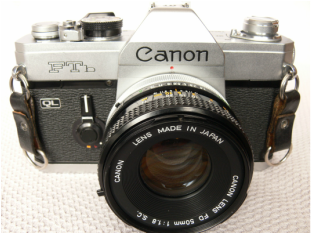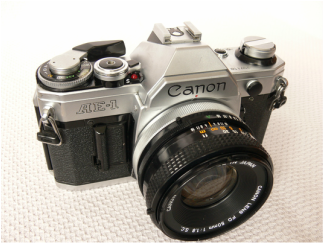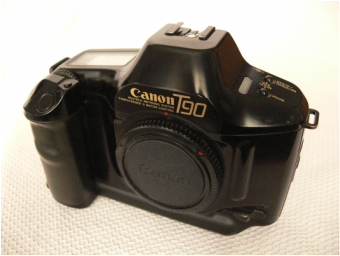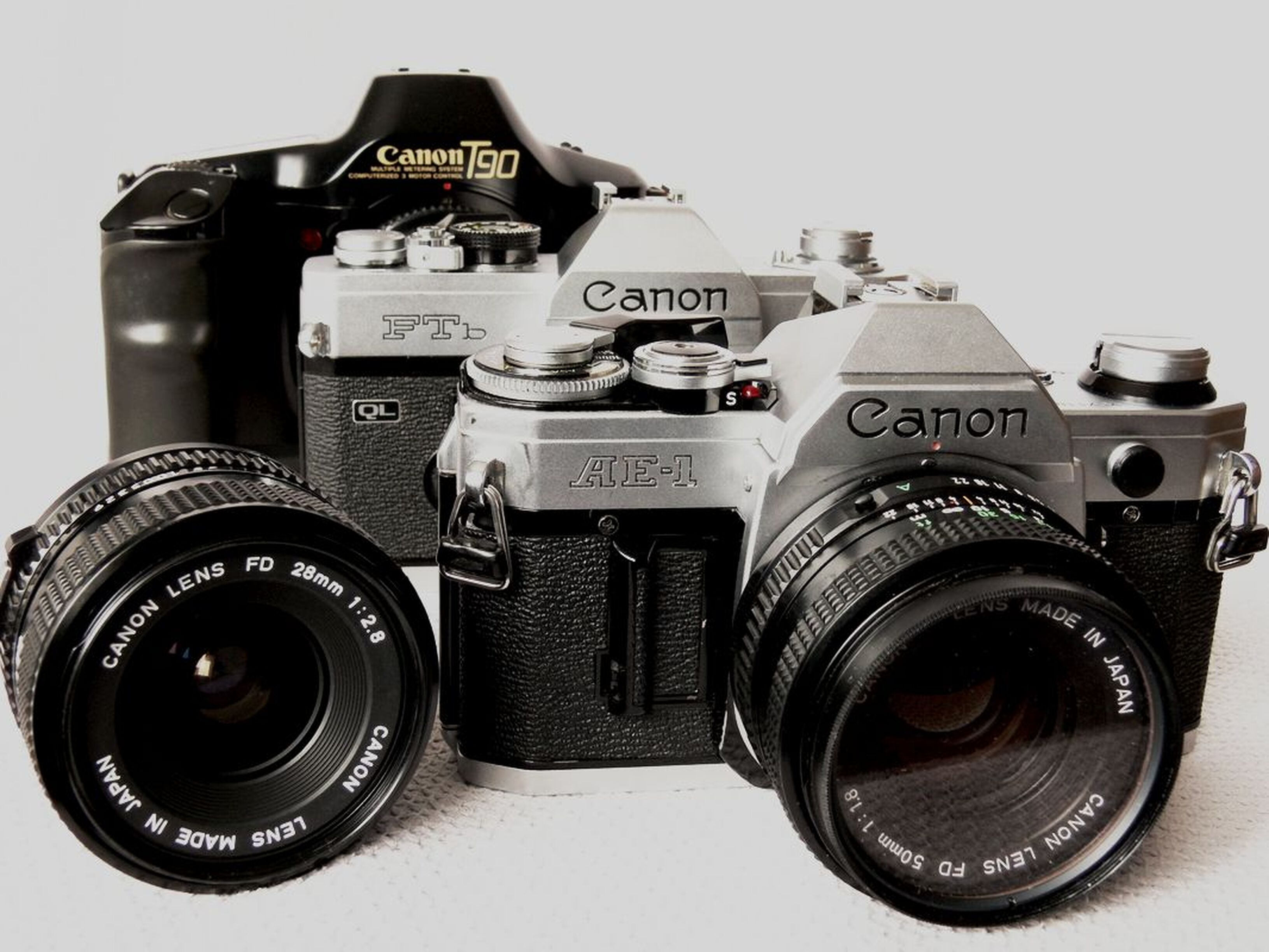|
Updated June 30, 2021 Welcome to our second system overview, this time featuring the Canon FL/FD system, in our "Choosing a Vintage SLR System" series. Following a brief introduction we will break things down via the format of 1) Lenses, 2) Bodies, 3) Flash, 4) Accessories, and 5) Reliability & Servicing. Canon was an early entrant into the SLR market in 1959 (the same year as Nikon) with its Canonflex model in what it called the R-mount. Compared to its competitors Asahi Optical Co. (Pentax), Chiyoda Kogaku (Minolta), and Nippon Kogaku (Nikon), Canon got off to a slower start in SLRs as far as sales went. This was due to a couple of factors: 1) Canon remained focused on the rangefinder market as the others went pretty much all-in on SLRs, and 2) the Flex and its immediate descendants the RP, and R2000 were quirky machines with a bottom plate-mounted film advance trigger which was rangefinder-derived. The R-mount, with its breech lock lens coupling, did serve as the basis for the succeeding FL and FD mounts, although it used different internal controls for aperture functions. With the final R-mount camera, the heavyweight RM (1962), Canon went more mainstream with the control configuration and it was their first SLR with a built-in meter. They still remained fourth in sales, however, because they trailed the other three manufacturers in camera/lens automation. This led them to introduce the FL-mount in 1964, which added fully automatic aperture control to lenses and laid the groundwork for their first TTL (through the lens) metered SLRs, the Pellix (1965) and the FT (1966). The FL-mount SLRs still required the user to manually stop-down the lens aperture to take an accurate meter reading (like the Pentax Spotmatic), whereas, by 1966, both Minolta and Nikon offered full-aperture TTL metering. It would take Canon until 1971 to adopt full-aperture metering with the introduction of the FTb and its newly christened FD lenses. That was the breakthrough they needed. The FL system had moved them into third place in sales by the mid-'60s and by 1972-73 the FD line became the top-selling SLR system, a position it would hold for the next decade. In 1979, Canon introduced its New FD line of lenses, featuring a faster, more convenient mounting system that was fully backwards compatible with all FD and FL bodies. With the debut of the new EOS EF auto focus mount in 1987, the FD mount's days were numbered. By the mid-'90s, it would become an orphan, which means bargains for the vintage SLR shopper today :-). But is the FL/FD system for you? Lenses The FL/FD lens lineup is one of the most extensive, stretching from 7.5mm fisheyes to 1200mm supertelephotos, in a wide array of maximum apertures. Canon pioneered the use of fluorite elements to combat chromatic aberration in SLR telephoto and supertelephoto lenses and also was an early adopter of aspheric (non-spherical) elements to improve optical performance. Lenses featuring these and other advanced optical technologies came to be designated as "L" lenses with a thin red stripe to distinguish them from the standard lineup, a practice Canon has continued to this day with their EF line of auto focus lenses. There were three basic generations of FL/FD lenses:
Features. Canon heavily promoted its "breech-lock" lens mounting system as superior to the bayonet mounts of other manufacturers. They claimed that there was no wear on the lens or camera flanges because the locking ring did the turning, as opposed to the flanges. While literally true, the amount of wear on the lens/camera flange on a conventional bayonet mount is so minimal that in practice there was no real advantage. This mounting system was not as fast or convenient as standard bayonets until the New FDs were introduced. Perhaps the greatest rebuttal to the purported superiority of the breech lock was Canon's own abandonment of it when they introduced the EF auto focus mount. Nevertheless, it works ;-). As with the other Japanese camera companies, the mid-to-late '60s brought major improvements in lens performance for Canon. This was primarily due to a co-operative effort (then-common in Japanese industry) among the lens manufacturers to develop new, high-performance glass types. Many new optical formulas were introduced and the evolution of multi coatings really began to accelerate. 1969 brought the debut of the first fluorite-equipped (to combat chromatic aberration, which becomes more apparent with longer focal lengths) lenses from Canon. Fluorite is actually a crystal, and does not "grow" large enough for lens-making purposes in its natural state, so Canon developed a way to manufacture fluorite crystals synthetically. This takes much time and expense, so fluorite-containing lenses are always a premium product. Canon initially distinguished such lenses with a thin green ring and "FLUORITE" engraved at the front of the lens. They would use this marking until 1978, when the introduction of the "L" designation with its red ring was from then on used for all high-performance lenses (although the green ring would return in the EF auto focus series to designate Diffractive Optical lenses). In 1971, Canon brought its first aspherical lens (the FD 55/1.2 AL) to market, with a special hand-ground element, to create the top-performing super-speed optic available at the time. The 55/1.2 AL (and its successor, the 50/1.2 AL S.S.C.) also featured a radioactive element containing thorium oxide that yellows over time, but can be cleared up via exposure to UV light. By the time the New FD lenses came along, Canon had developed automated aspheric-grinding machinery that greatly reduced the cost of producing such optics, and had also phased out the use of thorium glass. By the late 1980s, aspheric elements were being used in compact camera and consumer SLR lenses by most Japanese manufacturers. Build & Image Quality. Canon was the first of the Big 5 to make use of high-quality plastics to replace metal components in lens construction. The early FDs were all metal and glass (except the plastic front name ring), and were usually among the heaviest optics for their focal length/maximum aperture among the principal camera companies' offerings. By the mid-'70s, beginning with the second-generation FD lenses, Canon began to try and reduce weight and production costs by substituting aluminum for brass in certain components, and reducing the amount of aperture blades in their lower-end lenses. By the time the New FDs came along, plastic had really begun to take over. If you are looking for the lightest weight FD optics, these are your best bet. A New FD lens still has a much better manual focusing feel than any concurrent auto focus lens. The FLs are not as well-corrected optically as the later FDs, but some people prefer the rendering they give to go along with their better feel and construction. As far as coatings go, it is no contest, the S.S.C. lenses outperform any S.C. lens as far as resistance to flare and ghosting, and, in most cases, maintaining contrast with brighter light sources. How much that matters is again a personal decision. Using a hood with any lens (but especially non-S.S.C. versions) is always a good idea to maintain contrast. Noteworthy Lenses. In their adoption of aspherics and fluorite, Canon proved to be as innovative as any other member of the Big 5 during the '60s & '70s. Especially with their premium lenses did they push optical performance to new levels. Here are a few highlights from this period:
Miscellaneous. In the FL lineup, Canon basically used two filter sizes, the oddball 48mm for smaller-apertured lenses (and the super-telephotos with drop-in rear mounted filters) and the more standard 58mm for larger aperture optics. Exceptions were the FL-F 500/5.6 (95mm); the FL 100-200/5.6 (55mm); the FL 85-300/5 (72mm); the FL19/3.5R (Series 9 or 82.6mm). The FDs brought greater standardization, with 55mm being the normal size, with 58 and 72mm rounding out the front mount sizes. Drop-in filters for the big telephotos were either 34 or 48mm. For the New FDs the only change was a drop from 55 to 52mm as the normal filter size. Everything else carried over. Recommendations. The best bargains in FL/FD land are in the standard focal lengths and apertures. With the latest resurgence in the popularity of film (2020-onward), FD glass has taken a jump in value (to just about on par with Nikon glass) compared to some other orphaned mounts, such as Minolta SR (aka MC & MD). "L" lenses, while providing the ultimate in performance for the era, are in another price bracket, entirely. Particularly in FD mount, the aspherical (24/1.4; 55/1.2 AL; and 85/1.2) lenses come at a very steep price due to their rarity and hand ground elements. New FD versions generally come it at at least half of the price, due to changes in construction and higher production numbers. Canon was very strong in super telephotos, as well. They were taking a serious run at Nikon's position in the professional market, starting in 1970, particularly with high-speed and long-reach lenses. If you are into manual focus wildlife shooting you need to give the Canon FD series a close look. Prices for FD supertelephotos can be 1/2 of their modern EF (auto focus) equivalents (of course lacking 30 to 40 years of development and features like Image Stabilization) but are also trending upward. Image Stabilization for FD lenses requires a prehistoric contraption known as a "tripod". Be sure to include that in the cost of procuring such optics ;-).  Chrome FTb-N (1973) Chrome FTb-N (1973) Mechanical SLR Bodies F Series
Continuing with our timeline:
Recommendations. This will be pretty straightforward: if you are in the market for a mechanical Canon, the FTb-N and/or the F-1(N) (the original 1971-80 version) are the two top picks. There are plenty of FTbs & F-1s available, their only drawback being the 1.35V mercury cell for the meter. There are a few workarounds available, the C.R.I.S. adapter, installing a Schottky diode into the power chain, or using a handheld meter. The F-1 is about 100 grams (3.5 oz) heavier than the FTb-N, but does have a large assortment of accessories available to customize the camera to your needs. Very good to excellent FTb-Ns can be had from $40 - $80 USD, while F-1s go from $150 - 500 USD on average. The other mechanical bodies can do just fine, but you get the most features and best overall value out of these two bodies. Build quality is as good as it gets for Canon manual focus SLRs. Electronic SLR Bodies F Series
 Chrome AE-1 w/ FD 50/1.8 lens Chrome AE-1 w/ FD 50/1.8 lens A Series
Carrying on:
 The Ultimate FD Body...the T90 aka the 'Tank' The Ultimate FD Body...the T90 aka the 'Tank' T Series
Moving along:
Recommendations. This will be a little more involved than the mechanical bodies, just because of the sheer volume of models available. If you are a user of Canon EOS whether film or digital, the T90 will definitely feel most familiar as it was the progenitor of EOS ergonomics. The biggest issue with T90s seems to be that if they sit around unused for a while, the mirror and shutter electromagnets have a tendency to get sticky, causing the camera to lock up and/or display the dreaded "EEE" on the LCD. Have the electromagnets cleaned and the T90 usually lives up to its nickname, "the Tank". If you want traditional-style controls and top build quality, the EF is your camera. If you prefer less weight but similar capability, the AE-1 Program and standard AE-1 are next in line. A-1s have plenty of features but also seem to be less reliable in my experience than the less loaded A- bodies. They are also harder on batteries and the dials feel flimsier to me. The lower-end A bodies are less common but usually cheaper than the others, and you might find one that has enough features for you. A drawback to the A-series in general is their use of fairly expensive 6V batteries (if you avoid the cheap alkalines which have a short life). I use the Duracell PX28L lithium for the longest life and best cold weather performance in my A-bodies and it runs around $7-10 USD. Canon claimed up to 20,000 exposures or about a one-year lifespan for the 6V silver-oxide battery in the plain-Jane AT-1, and stuck to the one-year estimate in all other A-series bodies, which isn't too bad. All A-bodies have the propensity for the mirror dampener to develop the notorious "Canon squeal" as the lubricant dries out. It can be remedied without too much trouble, but finding a body without the squeal is not too difficult, although it can appear at any time. Flash Canon was never on the cutting edge of flash technology in the MF era. Though they heavily promoted their Canon Automatic Tuning (CAT) flash system in the '70s, it was, in reality, a cumbersome system that only worked with selected 35 & 50mm lenses. They didn't introduce a true TTL flash until the T90, which was ten years after Olympus, six years after Nikon & Pentax, and five years after Minolta. The 300TL was the flash introduced with the T90 that brought Canon into the TTL game. It debuted the hot shoe pin layout still used by the EOS cameras. It can be used on any older FD body with a hot shoe in auto sensor mode, making it the most versatile and desirable flash of the FD system. It can be had for $35 to $40 USD. There was also a TTL macro ring flash, the ML-2, that debuted with the T90. Accessories Canon had a decent amount of accessories in the FL era with: bellows, angle finders, corrective eyepieces, copy stands, and a low light meter booster attachment. When the F-1 came along, in 1971, it had a whole range of finders, interchangeable focusing screens, the first motor drive for a Canon, among other things. The amateur FDs carried on with a few additions like extension tubes for close-up photography. With the introduction of the AE-1 in 1976 came an explosion in amateur accessories: auto winders, motor drives, data backs, along with all of the previous FD accessories. The Motor Drive MA introduced with the A-1 was quite an innovation with an additional vertical shutter release button and high and low continuous speeds along with single frame advance. The only drawback was the huge 12-AA battery back required to power the drive. The MA is only recommended for the A-1 and AE-1 Program. The AE-1 Program was the first amateur Canon SLR that allowed the user to change focusing screens, with 8 different screens available, a feature that carried forward to the T90. A wireless infrared controller also became available with the A-series. The T-series eliminated the need for external film winders and motor drives, but you now had databacks (Command Backs in Canon-speak) that added additional shooting features like an intervalometer for the more advanced models. Electronic remote releases also debuted with the T-series. Reliability & Servicing The most rugged and reliable FD bodies are obviously the F-1s, intended as they were for professional punishment. But FTs and FTbs are very simple and rugged machines as well. The EF is a very well built machine, but definitely more complicated to work on than the mechanical models. The F series can be worked on by the few independent repairmen still out there. The abundance of A-bodies means that it is usually more economical to just replace the body if a computer or other electrical component fries. A-1s seem to suffer from more failures than AE-1s or AE-1 Programs, probably because there was a greater load on the electrical systems with the multiple exposure modes and the more power-hungry digital LED viewfinder display. Overall, the A-bodies are decently reliable for all of the cost-cutting that Canon did. The flimsy battery doors and the infamous "squeal" are probably the most common mechanical problems with them. The T90's issues with sticky electromagnets was documented earlier. Although the T90 is definitely the most complex FD body ever built, it is actually still quite serviceable by someone with a good background in electronics and a service manual, and Canon used better components in it than the lesser Ts. As with any other vintage SLR, it's not a bad idea to grab a parts body or two, to provide a little insurance with any of the Canon bodies. When it comes to lenses, a general rule is that the older the lens, the more pieces it can be broken down into for repair purposes. Newer lenses were more modular with lens blocks and aperture assemblies being replaced as single units rather than replacing a single element or part. Older lenses utilized aluminum-on-brass or aluminum-on-aluminum focusing helicoids, whereas most New FD lenses (the "L" lenses excluded) used plastic on aluminum. Ironically, aluminum-on-aluminum ages the worst out of the three constructions. This is because dissimilar materials have less molecular attraction, so that once lubricants break down or dry out, they can still move past each other quite easily. With all-aluminium helicoids, as they wear, aluminum particles become suspended in the lubricant and then, when the lubricant deteriorates, these particles cause more drag as they are caught in between the helicoid threads. This problem can be solved with disassembly, cleaning, and proper re-lubrication of the helicoid. Conclusion The Canon FL/FD system got off to a somewhat slower start than some of its competitors. However, by the mid-1970's it had risen to market dominance. By 1979, it also had the most extensive lens lineup of the Japanese manufacturers, with only Nikon having a comparable assortment of both standard and professional-level optics. While the "L" lenses are not cheap, they do offer levels of performance approached by few other optics of the period. As for standard glass, the FLs and FDs are some of the best bargains going. If you need big telephotos, the FDs deserve a long, hard look with Nikon, again, being the only other competitor on a close footing as far as selection and capability go. A wide variety of electronic bodies, and a smattering of excellent mechanical ones, should provide ample choices to meet your needs. If there was one area that Canon really lagged behind for awhile, it was flash. They did not bring out a true TTL flash until 1986 and the 300TL is the only real option and it works with any TTL or non-TTL body. Overall, the Canon manual focus system offers a lot for the 35mm film enthusiast to consider. Sources of information and reviews are the Canon Camera Museum and canonclassics.com. It is definitely worth your while to check them out. Next up: the Nikon F system. References: Canon Camera Museum @ http://global.canon/en/c-museum/ Canon FD Mount @ http://www.mir.com.my/rb/photography/photography.htm Canon Camera Manuals @http://www.butkus.org/chinon/canon.htm The EF Lens Concept (Eighth Edition, Sept. 2006)
4 Comments
Nicho
8/9/2020 12:12:25 pm
This is a wonderful review and very informational.
Reply
C.J. Odenbach
8/9/2020 12:45:11 pm
Glad you enjoyed it, Nicho. Thanks for the kind words. Take care.
Reply
Justin
2/21/2022 11:42:14 pm
I don't normally comment on posts like this but I felt the need to thank you for your efforts in creating this page. Going through the years and mentioning the main changes Canon made with each successor was very helpful. Thank you!
Reply
C.J. Odenbach
2/22/2022 09:35:00 am
Thanks for taking the time and effort to comment, Justin. Glad to hear that you found the article helpful. Best regards.
Reply
Your comment will be posted after it is approved.
Leave a Reply. |
C.J. OdenbachSuffers from a quarter-century and counting film and manual focus SLR addiction. Has recently expanded into 1980's AF point and shoots, and (gack!) '90s SLRs. He even mixes in some digital. Definitely a sick man. Categories
All
Archives
June 2024
|

 RSS Feed
RSS Feed